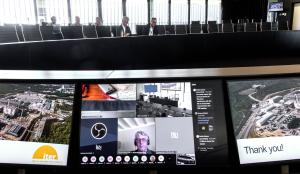New baseline to prioritize robust start to exploitation
At a press conference on 3 July attended by approximately 200 journalists and key ITER stakeholders, ITER Director-General Pietro Barabaschi answered questions about the new project plan—the "baseline"—that is under evaluation by the ITER Organization's governing body. The top-line messages were: ITER's programmatic goals have not changed; and the first experimental phase of the machine, although delayed, will be much more consequential than originally planned.
The new baseline replaces the plan that had been used as a reference since 2016, and which for some time had been publicly acknowledged to be no longer "feasible, practical or optimal." The major drivers of delay—the Covid pandemic that slowed factory work and inspections and added delay to the supply chain, and the repair required on key machine components—also created new opportunities to reconsider ITER's path to assembly and operation.
Whereas the 2016 plan made a low-energy, low-current first plasma the first major milestone—to be immediately followed by a multiyear assembly period to install major in-vessel components—the delay offered the project a new way forward: starting operations with a more complete machine.
The new baseline has been designed to prioritize a robust start to scientific exploitation. With a divertor, blanket shield blocks and other key components and systems in place, ITER's first operational phase, Start of Research Operation, will feature hydrogen and deuterium-deuterium plasmas that culminate in the operation of the machine in long pulses at full magnetic energy and plasma current.
"Instead of a symbolic first plasma that I liken to a 'machine test' achieved with a relatively 'naked' machine," says ITER Director-General Barabaschi, "in the new plan we will start by performing real research with plasma, leading to the demonstration of integrated commissioning at full magnetic energy and current. This is a robust start that will allow us to make up for some of the delay the project has accumulated, and also provide for better risk mitigation on the way to achieving project goals."
The new baseline also includes more time for integrated commissioning, the testing of some magnet coils at 4 K (minus 269 ° C), additional heating, and the availability of disruption mitigation. The material for the plasma-facing blanket first wall is also changing from beryllium to tungsten. "You will not find a fusion reactor project that plans to use beryllium," says the Director-General. "This modification makes our experiment more relevant to next-phase devices."
In the new plan, the achievement of full magnetic energy in 2036 represents a delay of three years relative to the 2016 reference, while the start of the deuterium-tritium operation phase in 2039 represents a delay of four years.
The Director-General was careful to stress that the "mission elements" of the project will not be modified—demonstrating the integration of systems needed for industrial-scale fusion operations; achieving a burning plasma with 500 MW of thermal fusion power for 50 MW input heating power (Q≥10); and 400-second pulses, reaching thermal equilibria (in plasma and structures).
As for the cost of the new plans, the ITER Director-General said that the additional cost for the ITER Organization amounts to EUR 5 billion—a figure that is still under review by the ITER Members. ITER costs historically have been difficult to estimate precisely because the bulk of financial contributions are provided in-kind by ITER Members in the form of components, for most of which Member governments are not required to publish their actual costs.
Read the summary document that was provided to journalists here.


